The Lagotto Romagnolo is an ancient breed of dog that comes from the Romagna sub‐region of Italy. All modern water retrieving dog breeds are believed to have descended in part from the Lagotto Romagnolo. The name means “lake dog from Romagna”. Historically, the Lagotto’s primary function was a water retriever. Over the years, the marshlands were drained and turned into farmland and the Lagotto lost his job. Later, the Lagotto found a new purpose in hunting for truffles. These dogs have a highly tuned nose for searching and they have been proven to be very efficient in truffle hunting.
About the Lagotto Romagnolo
For additional information about the Lagotto, please refer to the Lagotto Romagnolo Club of Canada for a wealth of information and support from dedicated Lagotto lovers.
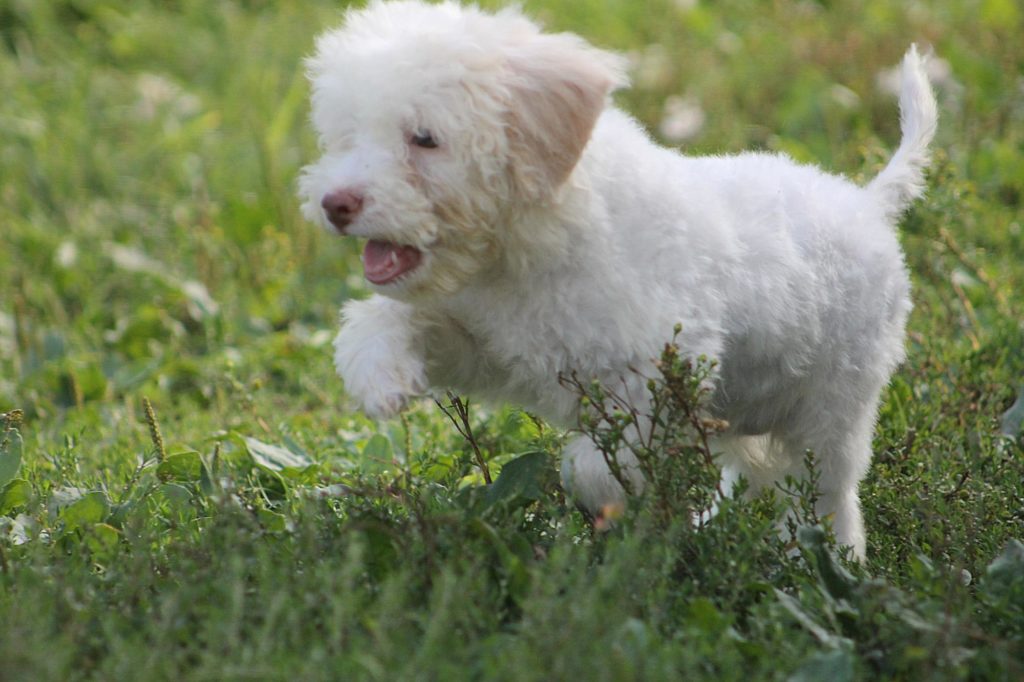
Appearance of the Lagotto Romagnolo
Colour
White, white with brown or orange spots, brown roan, orange roan, brown (in different shades) and orange. A Lagotto puppy may have dark brown markings but they should never be black, black and white or grey (although brown colour in an adult coat generally fades and can have a greyish appearance). Some dogs have a brown or dark brown mask. Tan markings are also accepted.
Coat & Grooming
The appearance of the Lagotto is attributed to the woolly‐textured hair. The spiral curls are evenly distributed over the body except on the head where the curls loosen. The coat is abundant on the head, including the whiskers, beard, cheeks and eyebrows. The coat of the Lagotto is water‐repellent. The hair may tend to felt so a complete clipping is necessary at least once per year. Because the Lagotto has hair rather than fur, there is very little shedding which makes them a popular choice for allergies sufferers. They require very little bathing as their coat is water-repellent.
Height
- Males: 43 ‐ 48 centimeters (~17 ‐ 19 inches)
- Females: 41 ‐ 46 centimeters (~16 ‐ 18 inches)
Weight
- Males: 13 ‐ 16 kg (~29 ‐ 35 lbs.)
- Females: 11 ‐ 14 kg (~24 ‐ 31 lbs.)
Life Span
11 ‐ 16 years
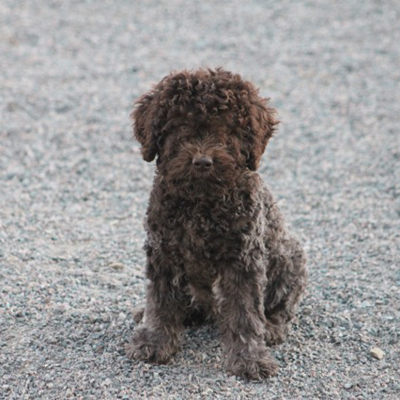
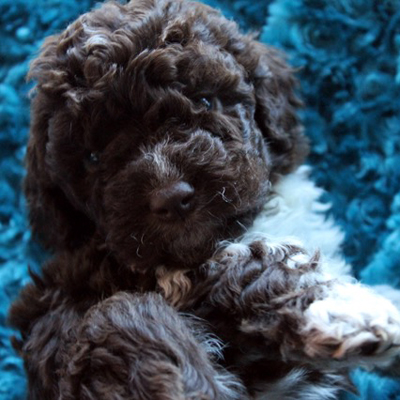


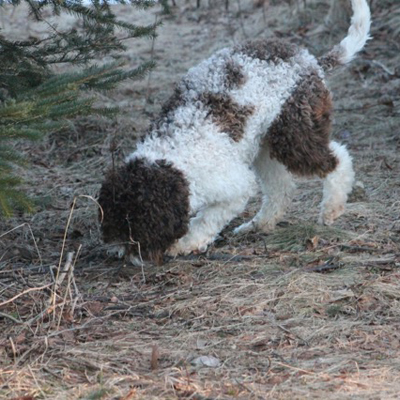

Temperament
The Lagotto Romagnolo is:
The Lagotto is bred for both physical and mental endurance, thus training must be mentally and physically stimulating.
Properly socialized, the Lagotto will get along well with other dogs, pets and have an affinity with children. Lagotto appreciate the company of their owner and are all too pleased to accompany you on long walks as they love the outdoors. They love the water and a good swim is always a treat. Lagotto also love to play seeking games and have very active minds. Consider tracking games, hide and seek or searching for mushrooms.
Lagotto are bred to dig and should be trained not to dig in yards. Consider offering them a sandbox or have an assigned spot for them to dig.
Lagotto tend to be quite successful at agility or obedience training. They are highly intelligent and it is important to keep their minds stimulated. They are skilled at focusing on the task at hand and are not easily distracted by other animals or scents.
Although the Lagotto’s instinct is to hunt, retrieve, swim and search, these qualities are inborn and do not necessarily have to be encouraged. Lagotto have to be trained to look for truffles at an early age.
Lagotto Health
There are very few genetic diseases associated with the Lagotto Romagnolo thus making them a very healthy breed. We minimize the risk of breeding sick puppies by health testing all of our breeding stock, although there are no certainties in the field of genetics. Dogs are living beings and although we have no control over their genetic predisposition, we can certainly reduce the risk of breeding sick puppies by not only health testing all of our breeding stock, but by studying the pedigrees of the puppies’ lineage and only breeding the healthiest & highest quality dogs to ensure that the future generations continue to be advocates for the standard of the breed.

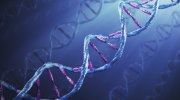

There are currently several options for breeders to publicly list and share their health testing results with the public. The OFA database is the leading tool in North America for listing health testing results in order to ensure that all families looking to purchase a puppy have access to see for themselves the results of the health testing results of the parents of their potential puppy.
Hip Dysplasia
 Hip dysplasia is an abnormal formation of the hip socket that, in its more severe form, can eventually cause crippling lameness and painful arthritis of the joints. It is believed to be a disease that is caused by various environmental factors stemming from a polygenic genetic base. In a hip suffering from dysplasia, the caput is not tightly held by the acetabulum (loose fit rather than a snug fit) and the caput or acetabulum are not smooth and round causing abnormal wear and tear within the joint as it moves. The joint may suffer degradation due to the abnormal wear and tear or may not support the body weight as intended. The joint becomes inflamed and a cycle of cartilage damage, inflammation and pain commences. The bones of the joint may also develop osteoarthritis, visible on an X-ray as small outcrops of bone, which further degrade the joint. The underlying deformity of the joint may get worse over time, or may remain static. A dog may have good X-rays and yet be in pain, or may have very poor X-rays and exhibit no symptoms at all. The hip condition is only one factor to determine the extent to which dysplasia is causing pain or affecting the quality of life. In mild to moderate dysplasia it is often the secondary effects of abnormal wear and tear or arthritis, rather than dysplasia itself, which is the direct causes of visible problems. The causes of hip dysplasia are considered heritable, however research conclusively implicates that environment also plays a significant role. To what degree the causality is genetic and what portion environmental is a topic of current debate. Environmental influences would include overweight condition, injury at a young age, overexertion on hip joint at a young age, ligament tear at a young age, repetitive motion on forming joint (i.e. jogging with puppy under the age of 1 year), etc. As current studies progress, greater information will help provide procedures to effectively reduce the occurrence of this condition. In dogs, the problem almost always appears by the time the dog is 18 months old. The defect can be anywhere from mild to severely crippling, and can eventually cause severe osteoarthritis. All of our breeding dogs are tested for hip dysplasia prior to being bred and only dogs receiving a passing score remain in our breeding program.
Hip dysplasia is an abnormal formation of the hip socket that, in its more severe form, can eventually cause crippling lameness and painful arthritis of the joints. It is believed to be a disease that is caused by various environmental factors stemming from a polygenic genetic base. In a hip suffering from dysplasia, the caput is not tightly held by the acetabulum (loose fit rather than a snug fit) and the caput or acetabulum are not smooth and round causing abnormal wear and tear within the joint as it moves. The joint may suffer degradation due to the abnormal wear and tear or may not support the body weight as intended. The joint becomes inflamed and a cycle of cartilage damage, inflammation and pain commences. The bones of the joint may also develop osteoarthritis, visible on an X-ray as small outcrops of bone, which further degrade the joint. The underlying deformity of the joint may get worse over time, or may remain static. A dog may have good X-rays and yet be in pain, or may have very poor X-rays and exhibit no symptoms at all. The hip condition is only one factor to determine the extent to which dysplasia is causing pain or affecting the quality of life. In mild to moderate dysplasia it is often the secondary effects of abnormal wear and tear or arthritis, rather than dysplasia itself, which is the direct causes of visible problems. The causes of hip dysplasia are considered heritable, however research conclusively implicates that environment also plays a significant role. To what degree the causality is genetic and what portion environmental is a topic of current debate. Environmental influences would include overweight condition, injury at a young age, overexertion on hip joint at a young age, ligament tear at a young age, repetitive motion on forming joint (i.e. jogging with puppy under the age of 1 year), etc. As current studies progress, greater information will help provide procedures to effectively reduce the occurrence of this condition. In dogs, the problem almost always appears by the time the dog is 18 months old. The defect can be anywhere from mild to severely crippling, and can eventually cause severe osteoarthritis. All of our breeding dogs are tested for hip dysplasia prior to being bred and only dogs receiving a passing score remain in our breeding program.
Juvenile Epilepsy
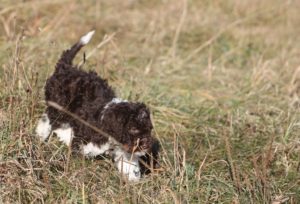 Juvenile Epilepsy is an epileptic syndrome in the Lagotto breed. Studies have shown that this disease is inherited and resembles idiopathic childhood epilepsies with benign outcomes in human. Testing indicates that seizures of puppies begin at 5 to 9 weeks of age and usually resolve by 8 to 13 weeks. There have been some adult-onset cases in the breed as well. Pedigree analysis suggests an autosomal recessive mode of inheritance. A lab in Finland studied the genetics of juvenile epilepsy in Lagottos and has recently identified the causative gene. If a dog carries one copy of the mutation it can transfer the gene defect to approximately 50% of its offspring. If the dog has two copies of the mutation it transfers the defect to its entire offspring. It is recommended that dogs that are homozygous for the Lagotto epilepsy mutation are withdrawn from breeding programs. Normal and carrier dogs can be used in breeding but it is advised to choose mutation-free partners for carriers. We test all of our breeding dogs for JE and only our JE free and JE carriers are bred. Our carriers are only bred to JE free partners to ensure that no affected puppies are born.
Juvenile Epilepsy is an epileptic syndrome in the Lagotto breed. Studies have shown that this disease is inherited and resembles idiopathic childhood epilepsies with benign outcomes in human. Testing indicates that seizures of puppies begin at 5 to 9 weeks of age and usually resolve by 8 to 13 weeks. There have been some adult-onset cases in the breed as well. Pedigree analysis suggests an autosomal recessive mode of inheritance. A lab in Finland studied the genetics of juvenile epilepsy in Lagottos and has recently identified the causative gene. If a dog carries one copy of the mutation it can transfer the gene defect to approximately 50% of its offspring. If the dog has two copies of the mutation it transfers the defect to its entire offspring. It is recommended that dogs that are homozygous for the Lagotto epilepsy mutation are withdrawn from breeding programs. Normal and carrier dogs can be used in breeding but it is advised to choose mutation-free partners for carriers. We test all of our breeding dogs for JE and only our JE free and JE carriers are bred. Our carriers are only bred to JE free partners to ensure that no affected puppies are born.
Improper Coat
 There is a rare gene that has been discovered in some lagotti known as the Improper Coat (IC) gene (also referred to as short coatedness). Although there are no reported cases of litters affected with IC in Canada, it is important to begin testing breeding dogs for this gene to ensure that it does not become prevalent in the breed. Lagotti who are affected with the Improper Coat gene are not ill and it is important to note that this gene affects the appearance of the dog but is not known to affect the health. Lagotti affected with the disorder differ in appearance from typical Lagotto Romagnolo. The short coat becomes apparent at the age of 7 – 8 weeks. Where the typical Lagotto will be developing curls throughout the body, the improper coated Lagotto will exhibit an unusually short coat, particularly on the head, ears and legs. As these Lagotti grow into adulthood, feathering on the body, ears and tail is generally visible, however the face and legs are short haired and will have a normal shedding cycle. Lagotti who are affected by an improper coat do not conform to the standard of the breed set forth by FCI and the CKC making them ineligible for the conformation show ring and thus should not be bred. Similar to Benign Familial Juvenile Epilepsy (BFJE), analysis suggests an autosomal recessive mode of inheritance for the Improper Coat. Normal and carrier dogs can be used in breeding but it is advised to choose mutation-free partners for carriers.
There is a rare gene that has been discovered in some lagotti known as the Improper Coat (IC) gene (also referred to as short coatedness). Although there are no reported cases of litters affected with IC in Canada, it is important to begin testing breeding dogs for this gene to ensure that it does not become prevalent in the breed. Lagotti who are affected with the Improper Coat gene are not ill and it is important to note that this gene affects the appearance of the dog but is not known to affect the health. Lagotti affected with the disorder differ in appearance from typical Lagotto Romagnolo. The short coat becomes apparent at the age of 7 – 8 weeks. Where the typical Lagotto will be developing curls throughout the body, the improper coated Lagotto will exhibit an unusually short coat, particularly on the head, ears and legs. As these Lagotti grow into adulthood, feathering on the body, ears and tail is generally visible, however the face and legs are short haired and will have a normal shedding cycle. Lagotti who are affected by an improper coat do not conform to the standard of the breed set forth by FCI and the CKC making them ineligible for the conformation show ring and thus should not be bred. Similar to Benign Familial Juvenile Epilepsy (BFJE), analysis suggests an autosomal recessive mode of inheritance for the Improper Coat. Normal and carrier dogs can be used in breeding but it is advised to choose mutation-free partners for carriers.
Lysosomal Storage Disease
 Lysosomal Storage Disease (LSD) is a rare metabolic disorder. Lysosomes transform undesirable or damaged cell matter into usable cell matter. In order to accomplish this, the lysosomes require enzymes and in cases where the enzymes are too few or absent, the transformation of the matter is impossible. As the undesirable matter intensifies, the cell loses its ability to function and through the multiplication of malfunctioning cells, the symptoms of the disease become apparent. LSD symptoms can be varied in nature with some cases having an early onset whereas others may only appear later in life. The severity of the symptoms can also be varied from mild to lethal. Some of the typical symptoms that you may expect to see in a dog that is affected with LSD are blindness, deafness, seizures, dementia, movement and developmental delays. Affected dogs typically appear completely normal at birth, however will fail to develop and flourish as expected or at the same rate as the siblings. In most cases, symptoms appear within the first year of life, although there are variations in the exact timing. It is important to note that symptoms are progressive and are generally fatal within 6 months of the onset of symptoms. Similar to Benign Familial Juvenile Epilepsy (BFJE), analysis suggests an autosomal recessive mode of inheritance for LSD. Normal and carrier dogs can be used in breeding but it is advised to choose mutation-free partners for carriers.
Lysosomal Storage Disease (LSD) is a rare metabolic disorder. Lysosomes transform undesirable or damaged cell matter into usable cell matter. In order to accomplish this, the lysosomes require enzymes and in cases where the enzymes are too few or absent, the transformation of the matter is impossible. As the undesirable matter intensifies, the cell loses its ability to function and through the multiplication of malfunctioning cells, the symptoms of the disease become apparent. LSD symptoms can be varied in nature with some cases having an early onset whereas others may only appear later in life. The severity of the symptoms can also be varied from mild to lethal. Some of the typical symptoms that you may expect to see in a dog that is affected with LSD are blindness, deafness, seizures, dementia, movement and developmental delays. Affected dogs typically appear completely normal at birth, however will fail to develop and flourish as expected or at the same rate as the siblings. In most cases, symptoms appear within the first year of life, although there are variations in the exact timing. It is important to note that symptoms are progressive and are generally fatal within 6 months of the onset of symptoms. Similar to Benign Familial Juvenile Epilepsy (BFJE), analysis suggests an autosomal recessive mode of inheritance for LSD. Normal and carrier dogs can be used in breeding but it is advised to choose mutation-free partners for carriers.
Neuroaxonal Dystrophy
 Neuroaxonal dystrophy is a neuro disorder which is quite rare. Thus far, there have not been any clinical signs of NAD found in any Lagotto Romagnolo, however due to the severity of this rare disorder, testing is recommended. In Spanish Water Dogs, clinical signs appear between 6-11 months of age and symptoms are gait abnormalities, abnormal vocalization, incontinence and behavioural changes. These symptoms are progressive and the mode of inheritance is autosomal recessive.
Neuroaxonal dystrophy is a neuro disorder which is quite rare. Thus far, there have not been any clinical signs of NAD found in any Lagotto Romagnolo, however due to the severity of this rare disorder, testing is recommended. In Spanish Water Dogs, clinical signs appear between 6-11 months of age and symptoms are gait abnormalities, abnormal vocalization, incontinence and behavioural changes. These symptoms are progressive and the mode of inheritance is autosomal recessive.







